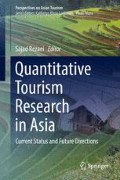Abstract
This chapter states the purpose and goals of the entire book covering the status and future directions of quantitative tourism research in Asia. As an introductory part, this chapter describes the scope of the book and provides a brief explanation and summary of chapters. As such, this chapter highlights the research paradigm, philosophy and design, and other quantitative-specific dimensions before intruding on each chapter. The chapters of the book are divided into 3 main parts including understanding tourism industry in Asia (Part I), the current status of quantitative techniques (Part II), and future directions for Asian tourism researches (Part III). In fact, the introduction chapter implicitly discusses how tourism context might be different from the other settings and argues that the creation of knowledge even in quantitative data analysis to some extent is context dependent. Therefore, this chapter discusses an overview of data analysis strategies that is often overlooked by researchers.
Access this chapter
Tax calculation will be finalised at checkout
Purchases are for personal use only
References
Banker, R. D., Charnes, A., & Cooper, W. W. (1984). Some models for estimating technical and scale inefficiencies in data envelopment analysis. Management Science, 30(9), 1078–1092.
Bassbasi, M., De Luca, M., Loele, G., Oussama, A., & Ragno, G. (2014). Prediction of the geographical origin of butters by partial least square discriminant analysis (PLS-DA) applied to infrared spectroscopy (FTIR) data. Journal of Food Composition and Analysis, 33(2), 210–215.
Burns, A. C., & Bush, R. F. (2002). Marketing research: Online research applications (4th ed.). New Jersey: Prentice Hall.
Buttery, E. A., & Buttery, E. M. (1991). Design of a marketing information system: Useful paradigms. European Journal of Marketing, 25(1), 26–39.
Byrne, B. M. (2013). Structural equation modeling with AMOS: Basic concepts, applications, and programming. New York: Routledge.
Churchill, G. A., & Iacobucci, D. (2004). Marketing research: Methodological foundations (9th ed.). Ohio: Thomson South-Western.
Crowley, S. L., & Fan, X. (1997). Structural equation modeling: Basic concepts and applications in personality assessment research. Journal of Personality Assessment, 68(3), 508–531.
do Valle, P. O., & Assaker, G. (2015). Using partial least squares structural equation modeling in tourism research a review of past research and recommendations for future applications. Journal of Travel Research, 55, 695–708.
Donthu, N., Hershberger, E. K., & Osmonbekov, T. (2005). Benchmarking marketing productivity using data envelopment analysis. Journal of Business Research, 58(11), 1474–1482.
Dorigo, W. A., Milla, R. Z., De Wit, A. J. W., Brazile, J., Singh, R., & Schaepman, M. E. (2007). A review on reflective remote sensing and data assimilation techniques for enhanced agroecosystem modeling. International Journal of Applied Earth Observation and Geoinformation, 9(2), 165–193.
Fornell, C., & Larcker, D. F. (1981). Evaluating structural equation models with unobservable variables and measurement error. Journal of Marketing Research, 18(1), 39–50.
Golob, T. F. (2003). Structural equation modeling for travel behavior research. Transportation Research Part B: Methodological, 37(1), 1–25.
Hair, J. F., Sarstedt, M., Ringle, C. M., & Mena, J. A. (2012). An assessment of the use of partial least squares structural equation modeling in marketing research. Journal of the Academy of Marketing Science, 40(3), 414–433.
Hair, J. F., Hult, G. T. M., Ringle, C. M., & Sarstedt, M. (2013). A primer on partial least squares structural equation modeling. Thousand Oaks: Sage.
Kline, R. B. (2015). Principles and practice of structural equation modeling. New York: Guilford publications.
Krauss, S. E. (2005). Research paradigms and meaning making: A primer. The Qualitative Report, 10(4), 758–770.
Liberati, A., Altman, D., Tetzlaff, J., Mulrow, C., Gøtzsche, P., Ioannidis, J., Clarke, M., Devereaux, P. J., Kleijnen, J., & Moher, D. (2009). The PRISMA statement for reporting systematic reviews and meta-analyses of studies that evaluate healthcare interventions: Explanation and elaboration. PLoS Medicine, 6(7), e1000100.
Lowry, P. B., & Gaskin, J. (2014). Partial Least Squares (PLS) Structural Equation Modeling (SEM) for building and testing behavioral causal theory: When to choose it and how to use it. IEEE Transactions on Professional Communication, 57, 123–146.
Nunkoo, R., & Ramkissoon, H. (2012). Structural equation modelling and regression analysis in tourism research. Current Issues in Tourism, 15(8), 777–802.
Panter, A. T., & Sterba, S. K. (2011). Handbook of ethics in quantitative methodology. New York: Routledge.
Peerbhay, K. Y., Mutanga, O., & Ismail, R. (2013). Commercial tree species discrimination using airborne AISA Eagle hyperspectral imagery and partial least squares discriminant analysis (PLS-DA) in KwaZulu–Natal, South Africa. ISPRS Journal of Photogrammetry and Remote Sensing, 79, 19–28.
Raines, D. A. P. E. R. N. A. (2013). Research paradigms and methods. Neonatal Network, 32(6), 425–428 Retrieved from https://vpn.utm.my/docview/1463807316?accountid=41678.
Saunders, M., Lewis, P., & Thornhill, A. (2009). Research methods for business students. Harlow: Pearson Education.
Sekaran, U. (2006). Research methods for business: A skill building approach. New Delhi: Wiley.
Trochim, W. M. K. (2006). The research methods knowledge base. (2nd ed.). Retrieved Date Accessed, 2012 from http://www.socialresearchmethods.net/kb/.
Weston, R., & Gore, P. A. (2006). A brief guide to structural equation modeling. The Counseling Psychologist, 34(5), 719–751.
Wolter, P. T., Townsend, P. A., & Sturtevant, B. R. (2009). Estimation of forest structural parameters using 5 and 10 mSPOT-5 satellite data. Remote Sensing of Environment, 113(9), 1–17.
Author information
Authors and Affiliations
Corresponding author
Editor information
Editors and Affiliations
Rights and permissions
Copyright information
© 2019 Springer Nature Singapore Pte Ltd.
About this chapter
Cite this chapter
Rezaei, S. (2019). Quantitative Methods, Applications, and Trends in Asian Tourism Research. In: Rezaei, S. (eds) Quantitative Tourism Research in Asia. Perspectives on Asian Tourism. Springer, Singapore. https://doi.org/10.1007/978-981-13-2463-5_1
Download citation
DOI: https://doi.org/10.1007/978-981-13-2463-5_1
Published:
Publisher Name: Springer, Singapore
Print ISBN: 978-981-13-2462-8
Online ISBN: 978-981-13-2463-5
eBook Packages: Business and ManagementBusiness and Management (R0)

